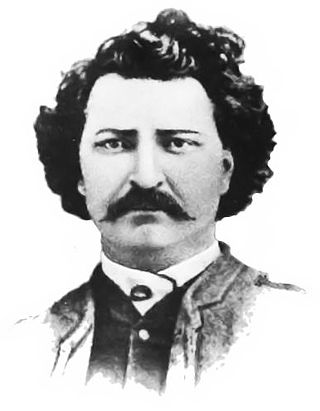
Louis Riel was a Canadian politician, a founder of the province of Manitoba, and a political leader of the Métis people. He led two resistance movements against the Government of Canada and its first prime minister John A. Macdonald. Riel sought to defend Métis rights and identity as the Northwest Territories came progressively under the Canadian sphere of influence.
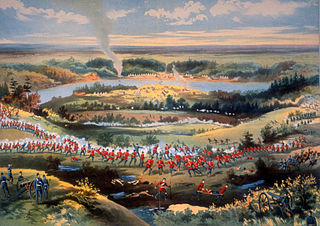
The North-West Rebellion, also known as the North-West Resistance, was an armed resistance movement by the Métis under Louis Riel and an associated uprising by Cree and Assiniboine of the District of Saskatchewan, North-West Territories, against the Canadian government. Many Métis felt that Canada was not protecting their rights, their land, and their survival as a distinct people. Fighting broke out in late March, and the conflict ended in June. About 91 people were killed in the fighting that occurred that spring before the conflict ended with the capture of Batoche in May 1885.

Pierre Gaultier de Varennes, sieur de La Vérendrye was a French Canadian military officer, fur trader, and explorer. In the 1730s, he and his four sons explored the area west of Lake Superior and established trading posts there. They were part of a process that added Western Canada to the original New France territory that was centred along the Saint Lawrence basin.
Assiniboia District refers to two historical districts of Canada's Northwest Territories. The name is taken from the Assiniboine First Nation.
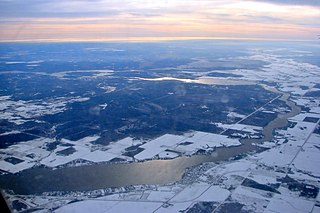
Winnipeg River is a Canadian river that flows roughly northwest from Lake of the Woods in the province of Ontario to Lake Winnipeg in Manitoba. This river is 235 kilometres (146 mi) long from the Norman Dam in Kenora to its mouth at Lake Winnipeg. Its watershed is 106,500 square kilometres (41,100 sq mi) in area, mainly in Canada. About 29,000 square kilometres (11,000 sq mi) of the watershed is in northern Minnesota, United States.
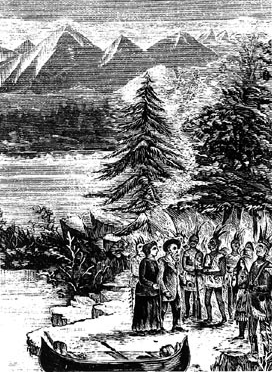
Marie-Anne Lagimodière was a French-Canadian woman noted as both the grandmother of Louis Riel, and as the first woman of European descent to travel to and settle in what is now Western Canada.
St. Louis is a village in the Canadian province of Saskatchewan within the Rural Municipality of St. Louis No. 431 and Census Division No. 15. It is south of the city of Prince Albert and northeast of Batoche.
Jacques Legardeur de Saint-Pierre was a Canadian colonial military commander and explorer who held posts throughout North America in the 18th century, just before and during the French and Indian War.

Fort La Reine was built in 1738 and is one of the forts of the western expansion directed by Pierre Gaultier de Varennes et de La Vérendrye, first military commander in the west of what is now known as Canada. Located on the Assiniboine River where present day Portage la Prairie, Manitoba, stands, the fort served as a fur trading post. It was also the base of operations for much exploration north and west. From Fort La Reine, explorers made their way to Lake Manitoba and Lake Winnipegosis, Lake Winnipeg and the Saskatchewan River.
The Methye Portage or Portage La Loche in northwestern Saskatchewan was one of the most important portages in the old fur trade route across Canada. The 19 km (12 mi) portage connected the Mackenzie River basin to rivers that ran east to the Atlantic. It was reached by Peter Pond in 1778 and abandoned in 1883 when steamboats began running on the Athabasca River with links to the railroad. It ranks with Grand Portage as one of the two most important and difficult portages used during the fur trade era.
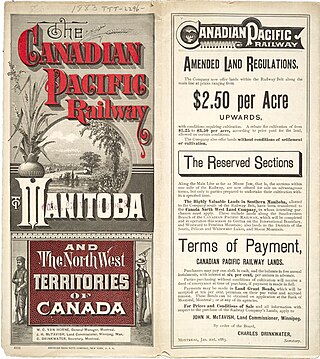
A block settlement is a particular type of land distribution which allows settlers with the same ethnicity to form small colonies. This settlement type was used throughout western Canada between the late 19th and early 20th centuries. Some were planned and others were spontaneously created by the settlers themselves. As a legacy of the block settlements, the three Prairie Provinces have several regions where ancestries other than British are the largest, unlike the norm in surrounding regions.
Fort Ellice was a Hudson's Bay Company trading post that operated from 1794 to 1892. It was first established in February 1794 by John Sutherland on the Qu'Appelle River about 20 kilometres (12 mi) upstream from its mouth at the Assiniboine River, and known as the Qu'Appelle River Post until it was destroyed by the North West Company in 1816.

Louis-François Laflèche was a Catholic bishop of the diocese of Trois-Rivières, in the province of Quebec, Canada.
Highway 49 and Provincial Trunk Highway 49 is a provincial highway in the Canadian provinces of Saskatchewan and Manitoba. Most of the highway is in the east-central part of Saskatchewan and only a very short section is in Manitoba. It runs from Saskatchewan Highway 35 between the communities of Fosston and Hendon to the Saskatchewan — Manitoba border, before ending at Provincial Trunk Highway 83 south of the community of Benito. The combined highway is about 166.4 kilometres (103.4 mi) in length — 165.2 kilometres (102.7 mi) is in Saskatchewan and 1.2 kilometres (0.7 mi) is in Manitoba.
Maxime Lépine was a Métis businessman and political figure from Canada. Lépine joined Louis Riel's provisional government in Red River in 1869. A founding member of the Union Saint-Alexandre, Lépine sought to bring together Métis of French-Canadian and Catholic origins. Later, Lépine represented St. Francois Xavier East in the Legislative Assembly of Manitoba from 1874 to 1878.

Arthur Jules Marion was a Métis politician and businessman. He was first elected as a Liberal MLA in the district of Île-à-la-Crosse in a by-election held in April 1926 after incumbent Joseph Octave Nolin died in office in December 1925. Marion would later be re-elected in the then-recently redrawn district of Athabasca in 1938. Notably, he had been earlier defeated in 1934 by Deakin Alexander Hall, who was also running Liberal.
In July 1941, a by-election was held to fill to the seat left vacant by Marion's own death in office in April 1941. Liberal Hubert Staines was elected to replace him. Marion's son Louis Marcien Marion successfully ran in the next Saskatchewan general election, and served as MLA in Athabasca from 1944 to 1952.
Joseph Noel Taillefer was a farmer, lawyer and political figure in Manitoba. He represented Ste. Agathe in 1879 and Morris from 1879 to 1883 as a Conservative.

James Emile Pierre Prendergast was a lawyer, judge and political figure in Manitoba. He represented La Verendrye from 1885 to 1888 and Woodlands from 1888 to 1892 and St. Boniface from 1892 to 1896 in the Legislative Assembly of Manitoba as a Conservative and later Liberal.
The Iron Confederacy or Iron Confederation was a political and military alliance of Plains Indians of what is now Western Canada and the northern United States. This confederacy included various individual bands that formed political, hunting and military alliances in defense against common enemies. The ethnic groups that made up the Confederacy were the branches of the Cree that moved onto the Great Plains around 1740, the Saulteaux, the Nakoda or Stoney people also called Pwat or Assiniboine, and the Métis and Haudenosaunee. The Confederacy rose to predominance on the northern Plains during the height of the North American fur trade when they operated as middlemen controlling the flow of European goods, particularly guns and ammunition, to other Indigenous nations, and the flow of furs to the Hudson's Bay Company (HBC) and North West Company (NWC) trading posts. Its peoples later also played a major part in the bison (buffalo) hunt, and the pemmican trade. The decline of the fur trade and the collapse of the bison herds sapped the power of the Confederacy after the 1860s, and it could no longer act as a barrier to U.S. and Canadian expansion.










